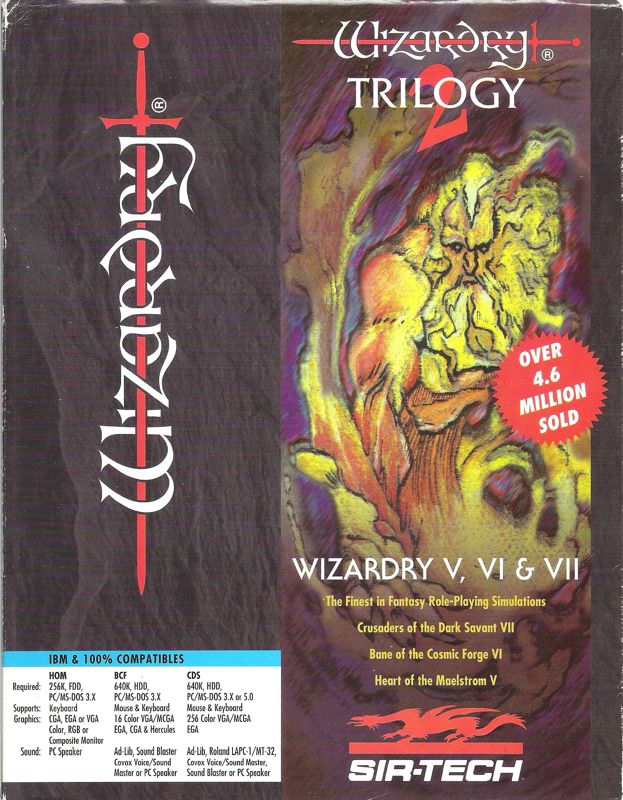Retro Replay Review
Gameplay
The Wizardry Trilogy 2 compilation delivers the classic first‐person, turn‐based dungeon‐crawling experience that defined mid-’90s computer RPGs. Across Heart of the Maelstrom, Bane of the Cosmic Forge, and Crusaders of the Dark Savant, you guide a party of adventurers through multi‐level mazes, engaging in grid‐based exploration, tactical combat, and puzzle solving. Character creation remains deep and nuanced: you select races, professions, and alignment, then develop skills through careful level‐up choices. The synergy of your party composition can radically alter encounter outcomes, making each playthrough feel uniquely challenging.
Combat unfolds in a classic initiative order, with options to attack, cast spells, use items, or attempt retreats. Each game refines this system slightly—Heart of the Maelstrom emphasizes elemental hazards, Bane of the Cosmic Forge introduces powerful artifacts that shift encounter dynamics, and Crusaders of the Dark Savant raises the stakes with adjustable difficulty tiers. The pacing stays deliberate, rewarding methodical planning and resource management, while a persistent autosave and faster text scrolling in modern ports ease some of the original’s rough edges.
Puzzles and side‐quests pepper the dungeons, providing welcome detours from monster grinding. You’ll hunt for hidden levers, decode cryptic scrolls, and piece together lore fragments to unlock sealed doors or optional bosses. These challenges range from simple fetch quests to more intricate riddles that demand backtracking and keen observation. For veteran CRPG enthusiasts, the level design feels both nostalgic and satisfying, striking a balance between nostalgia and substance.
Graphics
Visually, this trilogy stays true to its mid‐’90s heritage: low‐resolution sprites, flat textures, and a limited color palette. The minimalist presentation focuses attention on atmosphere rather than flashy effects. While Heart of the Maelstrom’s corridors appear stark and foreboding, Bane of the Cosmic Forge introduces more varied tile sets—icy caverns, molten chambers, and arcane laboratories—adding visual diversity. Crusaders of the Dark Savant ramps up detail further, with richly colored wall textures and occasional animated effects for lava flows and glowing runes.
The user interface sees incremental refinements from one game to the next. Inventory and spell menus become more streamlined, with clearer icons and tooltips to reduce confusion. Character portraits remain static but evocative, capturing each race and class archetype with pixel‐art charm. While purists may miss high-definition overhauls, the authentic retro style is part of the package’s enduring appeal. For newcomers, the slight blur of pixel edges and simple geometry may feel quaint, yet it reinforces the sense of exploring an uncharted labyrinth.
Performance is rock‐solid on modern systems, thanks to built-in compatibility layers and adjustable frame rates. Even on high‐resolution monitors, the graphics scale cleanly without distortion or warping. Fans have also created optional graphical filters to emulate CRT scan lines or smooth pixels, giving players freedom to choose their preferred aesthetic. Overall, the trilogy’s visual design remains functional, atmospheric, and faithful to the original D.W. Bradley vision.
Story
Each installment in Wizardry Trilogy 2 tells a self-contained story while weaving into a broader cosmic tapestry. In Heart of the Maelstrom, your party investigates a mysterious warp gate spewing elemental chaos into the world, setting the stage for interdimensional threats. Characters you rescue and artifacts you unearth hint at an ancient power struggling to maintain balance. Though the narrative is succinct, in-game dialogue and journal entries enrich the backdrop with hints of political intrigue among mages and warrior orders.
Bane of the Cosmic Forge delves deeper into the repercussions of tampering with powerful relics. As the titular Cosmic Forge threatens to rewrite reality, you navigate alliances with cryptic factions and confront moral dilemmas: sacrifice a comrade to save a city, or risk everything to preserve your party’s integrity? These branching choices, though subtle, lend greater agency and replay value. The story’s tone shifts toward cosmic horror, emphasizing how mortals can become pawns in the schemes of higher powers.
Crusaders of the Dark Savant delivers a grand finale worthy of the trilogy. A rogue AI—known as the Dark Savant—seeks to conquer both organic and arcane realms. The narrative’s scope expands, incorporating interplanetary travel, philosophical debates on artificial intelligence, and tense confrontations with iconic villains. While the dialogue remains utilitarian by modern standards, key moments pack an emotional punch, especially when long‐standing NPC allies reappear at critical junctures. The overarching plot ties back to threads from the first two games, rewarding players who have tracked every clue.
Overall Experience
Wizardry Trilogy 2 is a treasure trove for fans of deep, methodical RPGs. The combined runtime of three full games offers hundreds of hours of content: character leveling, exploration, puzzle solving, and combat. The compilation presents great value, seamlessly bundling D.W. Bradley’s most ambitious Wizardry designs in one package. Modern enhancements—autosave, hotkeys, and resolution scaling—make the experience accessible, though newcomers should brace for an old-school learning curve.
Difficulty remains high but fair. Early encounters can be unforgiving if you neglect healing potions or party balance, yet triumphing over brutal foes yields immense satisfaction. Side-quests and hidden areas encourage exploration, and the sense of discovery never fully fades even in the third title. Multiplayer support for hot-seat party sharing adds a social layer, allowing friends to rotate DM-style roles in party building and decision making.
In sum, Wizardry Trilogy 2 stands as a definitive collection of classic CRPG design. Its blend of tactical depth, atmospheric dungeons, and interlocking narratives offers a rewarding challenge for dedicated role-players. Though its retro presentation may not appeal to every modern gamer, fans of nostalgic, rule-heavy adventures will find themselves enthralled by the trilogy’s enduring magic. For those seeking a substantial, brain-teasing journey through wizard-infested labyrinths, this compilation remains a must-own title.
 Retro Replay Retro Replay gaming reviews, news, emulation, geek stuff and more!
Retro Replay Retro Replay gaming reviews, news, emulation, geek stuff and more!




Reviews
There are no reviews yet.